A Study on the Inheritance and Differentiation of Spatial Forms of Vernacular Architecture in the Yunnan–Tibet Area
Abstract
1. Introduction
2. Materials and Methods
2.1. Study Area and Objects
2.1.1. Main Building Type
2.1.2. Building Courtyard Combination Type
2.1.3. Patio Courtyard Compound Type
2.2. Space Syntax
2.3. Min–Max Normalization
2.4. Kendall’s W Test
3. Results
3.1. Justified Plan Graphs
3.1.1. Multi-Layer Tree Structure
3.1.2. Tree-Ring Assemblage Structure
3.2. Global and Local Calculation Results
3.3. Kendall’s W Test Results
3.4. Differentiated Comparison Results
4. Discussion
4.1. Analysis of Spatial Configuration Relationships
4.2. Analysis of Inheritance Factors
4.2.1. Privacy of the Granary Space
4.2.2. Centrality of the Corridor Space
4.2.3. Transportability of the Breeding Area Space
4.2.4. Independence of the Scripture Hall Space
4.3. Differentiation Factor Analysis
4.3.1. Functional Evolution of Traditional Space
4.3.2. Reorganization of the Location of the Breeding Area Space
4.3.3. “Toilet Revolution” with Multiple Drivers
5. Conclusions
Author Contributions
Funding
Data Availability Statement
Conflicts of Interest
References
- Zhong, Z. Decoration Room: A Study on the Regeneration and Cultural Context of Li Traditional Houses in Tourism Landscape Design. Furnit. Inter. Decor. 2025, 32, 130–134. [Google Scholar]
- Wang, Z. Discussion on the industrial development mode of Zhouhuang historical and cultural heritage. Soc. Sci. 2025, 71–81. [Google Scholar]
- Luo, Y.; Xu, Y.; Wang, M.; Huang, C.; Zhu, Y. Visiting sequence:A research perspective on the identification and interpretation of the value of historical gardens. Chin. Landsc. Archit. 2025, 1–8. Available online: http://kns.cnki.net/kcms/detail/11.2165.TU.20250403.1345.002.html (accessed on 7 May 2025).
- Zhou, Q.; Liang, H.; Yang, Y.; Zhang, C. The “core” and “periphery” in the Dai house—Taking Meng Lian Na Yun as an example. Archit. J. 1–7. Available online: http://kns.cnki.net/kcms/detail/11.1930.TU.20250427.1138.006.html (accessed on 7 May 2025).
- Zhang, H.; Peng, H.; Gao, J.; Wang, F.; Zhu, P. Evaluation and renewal mechanism of cultural tourism development potential of urban built heritage: A case study of the main urban area of Dalian. Nat. Resour. 2025, 40, 1504–1522. [Google Scholar] [CrossRef]
- Antón, A.M.; Patiño, G.L.; Blanca-Gimenez, V.; Clemente, I.T. Analysis of the Hygrothermal Conditions of the Vinalopó Medio Cave Houses (Alicante, Spain). Tunn. Undergr. Space Technol. 2025, 162, 106611. [Google Scholar] [CrossRef]
- Haoying, L.; Ming, L. Adaptive Changes to Korean Vernacular Houses in Northeast China: The Influence of Changing Family Patterns on Spatial Capacity. Open House Int. 2025, 50, 324–348. [Google Scholar]
- Bigiotti, S.; Santarsiero, M.L.; Del Monaco, A.I.; Marucci, A. A Typological Analysis Method for Rural vernacular architecture: Architectural Features, Historical Transformations, and Landscape Integration: The Case of “Capo Due Rami”, Italy. Land 2025, 14, 374. [Google Scholar] [CrossRef]
- Shao, Y.; Chen, Y. Research and Practice on Protection and Design Guidelines for Historic Towns—Taking Pingyao as an Example. J. Urban Plan. 2020, 6, 102–109. [Google Scholar]
- Ding, Z.; Chen, Y. Cultural Origins and the Protection and Inheritance of Traditional Houses—An Examination Based on the Traditional Houses of the Cai Clan in Fujian. Guangxi Ethn. Stud. 2020, 4, 109–116. [Google Scholar]
- Luxi, Y. A Critical Analysis of the Yin Yu Tang Project and the Preservation of Huizhou-Style vernacular architecture in China. Tradit. Dwell. Settl. Rev. 2022, 34, 18. [Google Scholar]
- Li, T.; Zhang, M.; Gu, X. Optimization Strategies for Conservation of Traditional vernacular architecture in Hongcun Village, China, Based on Decay Phenomena Analysis. PLoS ONE 2022, 17, e0276306. [Google Scholar]
- Hao, L.Y. Research on the Conservation and Utilization of Subtropical Island Stone vernacular architecture in China. J. Sci. Des. 2022, 6, 41–50. [Google Scholar]
- Li, T.; Zhang, M.; Gu, X. The Research on the Evaluation and Optimization of the Traditional Dwelling Conservation Practice: A Case Study of Cheng Zhi Hall Restoration Project within Hongcun. J. Archit. Res. Dev. 2020, 4, 5–9. [Google Scholar] [CrossRef]
- Wang, R. Design and Implementation of Traditional Residential Protection and Development System Based on View of Landscape Information Chain. J. Phys. Conf. Ser. 2019, 1345, 062053. [Google Scholar] [CrossRef]
- Sun, P. “Survival-Growth-New Life”—Schematic Design of Cellar Village Renovation. Build. Struct. 2022, 52, 176. [Google Scholar]
- Wang, H.; Zhang, H.; Wang, J. Evaluation of Residential Suitability of Traditional Residential Hammock in Qiandongnan. Guizhou Ethn. Stud. 2022, 43, 132–137. [Google Scholar]
- Yan, N.; Gao, M.; Feng, J.; Zhou, Z. Design Intervention and Co-Creation: The Case of Gao Dang Buyei Mountain Village. Decoration 2022, 4, 42–47. [Google Scholar]
- Solang, B.; Chang, Q. Research on Climate Adaptation of Traditional Residential Buildings in Lhasa. J. Xi’an Univ. Archit. Technol. (Nat. Sci. Ed.) 2020, 52, 416–423. [Google Scholar]
- Liang, M.; Bian, G. A Strategic Study on the Ecological Transformation of Rural vernacular architecture in Lingnan Region—Taking the Example of Xiangang Villagers’ Residence Transformation Project in Foshan. J. Hunan Univ. Sci. Technol. (Nat. Sci. Ed.) 2019, 34, 46–52. [Google Scholar]
- Sun, Y.; Solang, B.; Li, H.; Xiao, Y.; Zhang, Z. Research on the Contemporary Construction of the Main Room Space of Traditional Qiang vernacular architecture. Chin. Cult. Forum 2017, 6, 170–174. [Google Scholar]
- Li, J.; Chen, M.; Xu, H.; Yin, Q.; Pu, Y. A Study on the Evolution of Raw Soil Dwelling Types in Inner Mongolia along the Route of the Westward Exit. J. Archit. 2024, 22–27. [Google Scholar]
- Lin, X.; Jia, B. Differentiation and Transformation—Evolution of Spatial Types of Durian Residences from Ming and Qing Dynasties to Contemporary Times in Taishun Area, South Zhejiang. J. Archit. 2023, 76–81. [Google Scholar]
- Wang, X.; Wei, Y. Research on the Design of Traditional Residential Remodeling Based on Schema Fusion—Taking Phoenix Inn as an Example. Decoration 2023, 09, 124–127. [Google Scholar]
- Ding, C.; Zhuo, X.; Xiao, D. Ethnic Differentiation in the Internal Spatial Configuration of Vernacular vernacular architecture in the Multi-Ethnic Region in Xiangxi, China from the Perspective of Cultural Diffusion. Herit. Sci. 2024, 12, 3. [Google Scholar] [CrossRef]
- Lei, Z.; Li, J. Genotype Extraction of Traditional vernacular architecture Using Space Syntax: A Case Study of Tibetan Rural Houses in Ganzi County, China. npj Herit. Sci. 2025, 13, 13. [Google Scholar] [CrossRef]
- Yao, Z.; Ismail, A.S. Huizhou Residences under the Influence of Zhu Xi Neo-Confucianism. Cogent Arts Humanit. 2024, 11, 2438477. [Google Scholar] [CrossRef]
- Gökçen, D.; Özbayraktar, M. Integrating Space Syntax and System Dynamics for Understanding and Managing Change in Rural Housing Morphology: A Case Study of Traditional Village Houses in Düzce, Türkiye. Environ. Dev. Sustain. 2024, 26, 1–29. [Google Scholar] [CrossRef]
- Lasiewicz-Sych, A.; Lewicka, M. The Engagement of Polish Residents with Their Home Space in Single-Family Houses and Flats in Multi-Family Blocks of Flats. J. Hous. Built Environ. 2024, 39, 1035–1062. [Google Scholar] [CrossRef]
- França, F.C.; Greene, M. The Poet Neruda’s Environment: The Isla Negra House. Environ. Plan. B Urban Anal. City Sci. 2018, 45, 713–732. [Google Scholar] [CrossRef]
- Wang, L.-H. Tibetan Folk Houses in Yunnan; Yunnan Science and Technology Press: Kunming, China, 2008. [Google Scholar]
- Yang, D. Crystallization of Two Cultures—Tibetan Houses in Zhongdian, Yunnan. Cent. China Archit. 1998, 4, 135–137. [Google Scholar]
- Liu, H.; Yang, C.; Su, Y.; Qiang, M.; Zhou, X.; Yuan, Z. A Study on the Atlas and Influencing Factors of Architectural Color Paintings in Tibetan Timber vernacular architecture in Yunnan. Buildings 2024, 14, 3971. [Google Scholar] [CrossRef]
- Wang, H.; Kang, W.; Su, Y.; Li, F.; Qiang, M. Relationship Between Visual Attractiveness and Aesthetic Preference of Door Decoration Patterns of Wood-Framed vernacular architecture in Yunnan-Tibet. J. For. Eng. 2025, 6, 1–9. [Google Scholar]
- Li, Z.; Tang, R.; Ji, J.; Qiu, J. Conflict and Countermeasures of Yunnan Tibetan Houses in Contemporary Protection and Needs Under the Perspective of Fire Safety. Archit. Cult. 2021, 10, 254–256. [Google Scholar]
- Shan, J.; Tie, L. A Study on Spatial Schema of Tibetan Houses in Yunnan. Settlement 2011, 6, 116–122. [Google Scholar]
- Zhang, W.; Wang, M. Exploration of the Formal Characteristics and Causes of Traditional Tibetan Houses in Diqing, Yunnan—Based on the Field Survey and Comparative Study of Tangman Village. J. Southwest Univ. Natl. (Humanit. Soc. Sci. Ed.) 2022, 43, 34–42. [Google Scholar]
- Che, M. Contacts, exchanges, and blending of various ethnic groups are the mainstream of the historical development of the Tibetan people. Tibet. Stud. 2020, 46–55. [Google Scholar]
- Lin, J. On the belief of the gods in Tibet. Stud. Ethn. Lit. 2003, 3, 79–82. [Google Scholar]
- He, Q.; Lv, X.; Liu, J. Research on the psychological defense mechanism in the Tibetan settlement environment. Archit. J. 2010, 68–71. [Google Scholar]
- Zhou, T.; Han, X. The Formation of Early Tibetan Folk Beliefs and the Integration and Adaptation of Buddha and Benzene--Ancient Tibetan Manuscripts of Bon in the Fifth and Sixth Centuries. J. Lanzhou Univ. (Soc. Sci.) 2011, 39, 42–48. [Google Scholar]
- Jiangbian, J. On the concept of “yang” and the nature worship of the Tibetan ancestors. Tibet. Stud. 1994, 1, 99–104. [Google Scholar]
- Angben, D. History of Tibetan Culture Development; Gansu Education Press: Gansu, China, 2001; Volume I. [Google Scholar]
- Yang, W. On the influence of Tibetan Buddhist belief on Tibetan social psychology and behavior. J. Southwest Univ. Natl. (Humanit. Soc. Sci.) 2011, 32, 17–23. [Google Scholar]
- Zhang, Z. Tibetan Journal: Listening to the Sounds of the Countryside: The Life and Culture of the Tibetans in Yunnan; Yunnan University Press: Kunming, China, 2006. [Google Scholar]
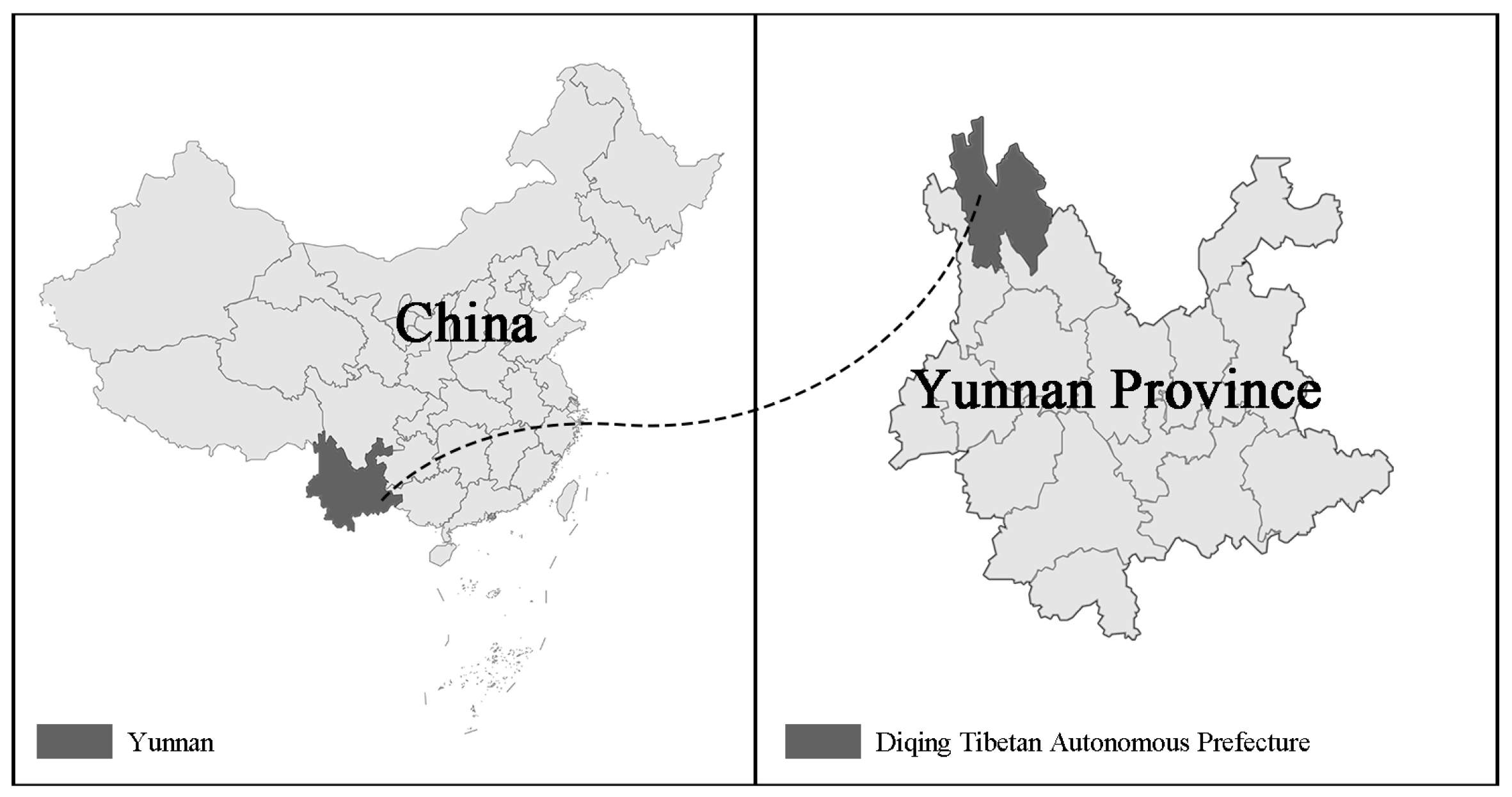

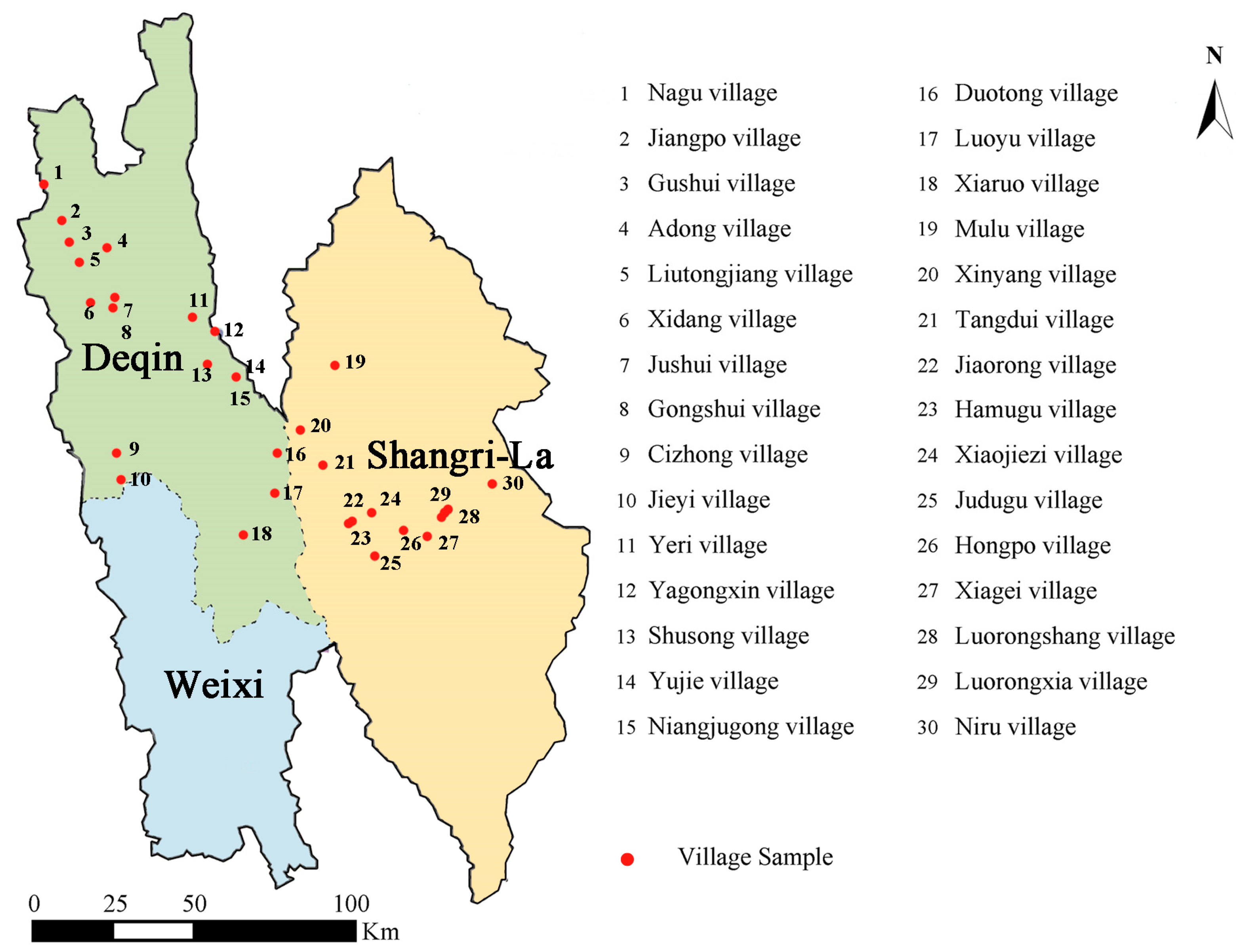
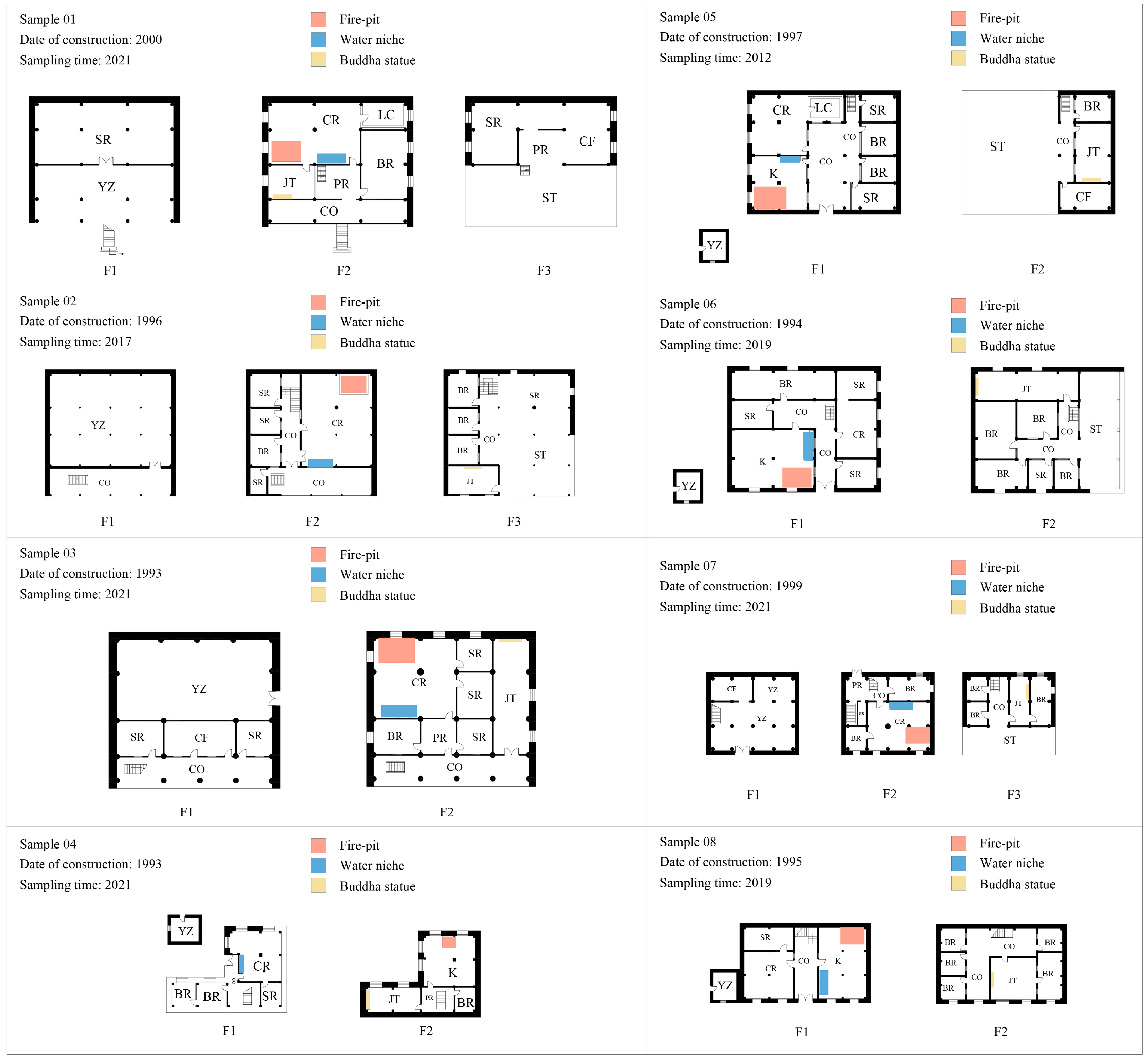
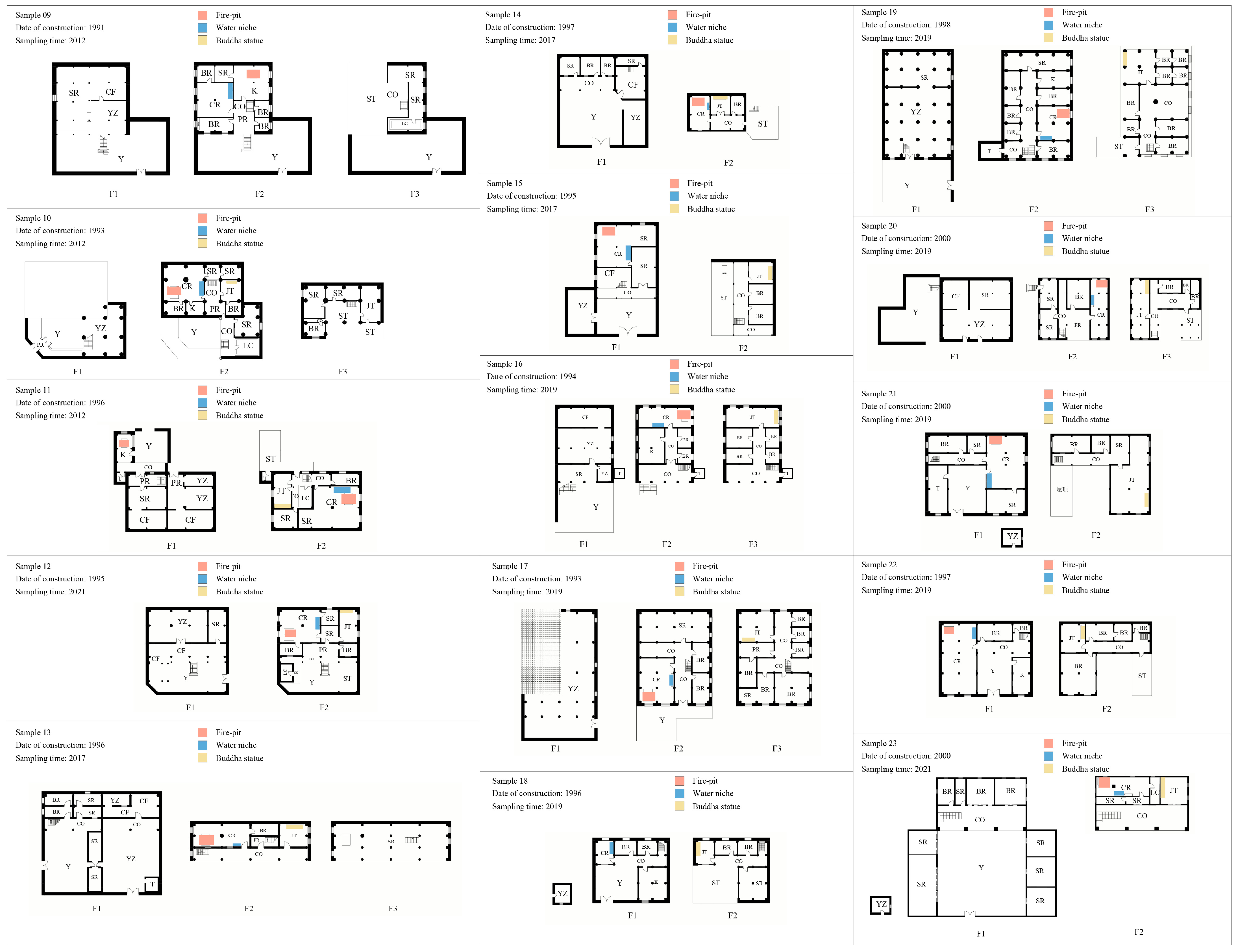
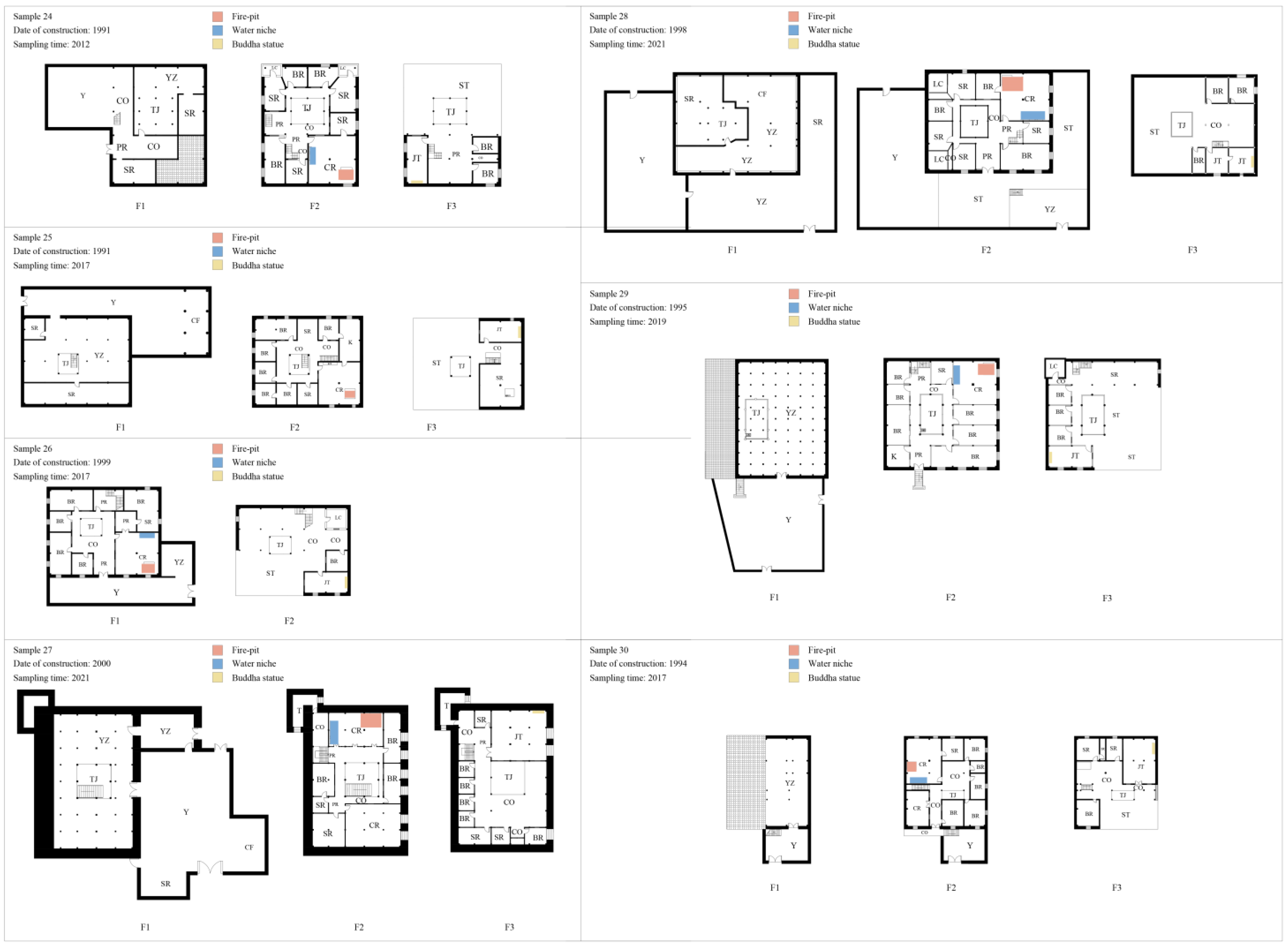
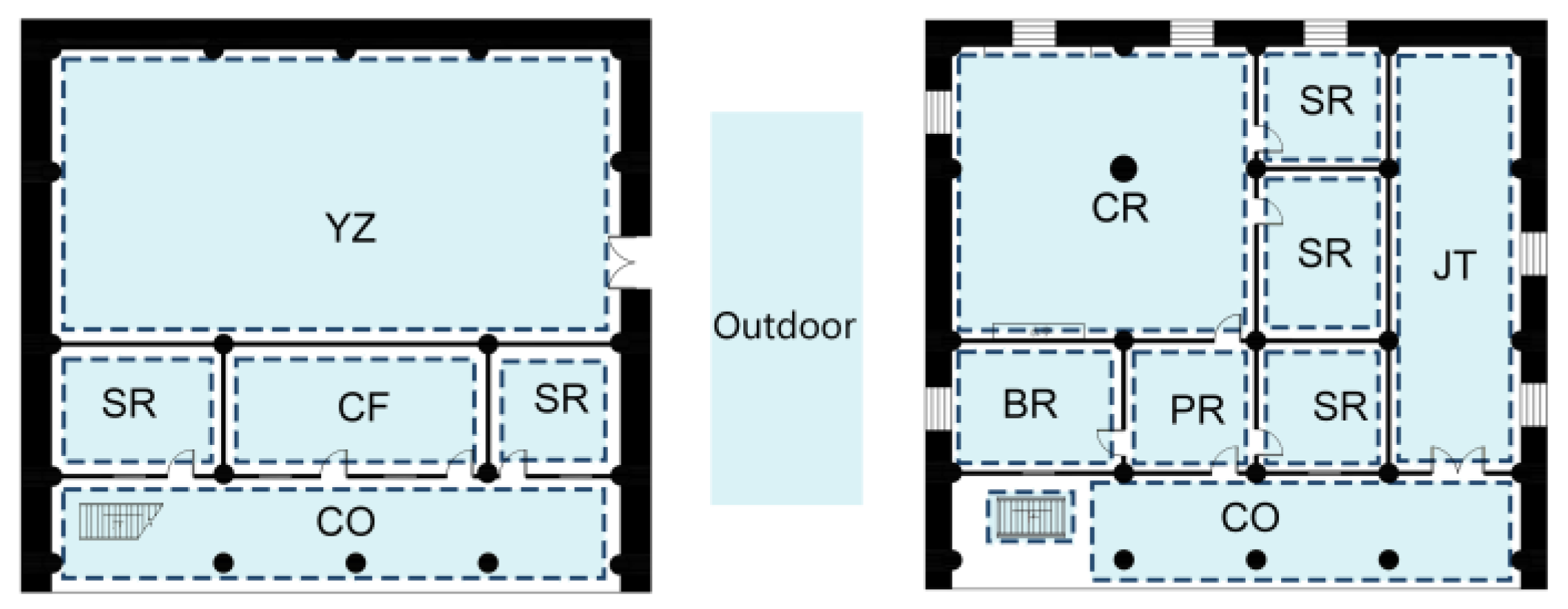
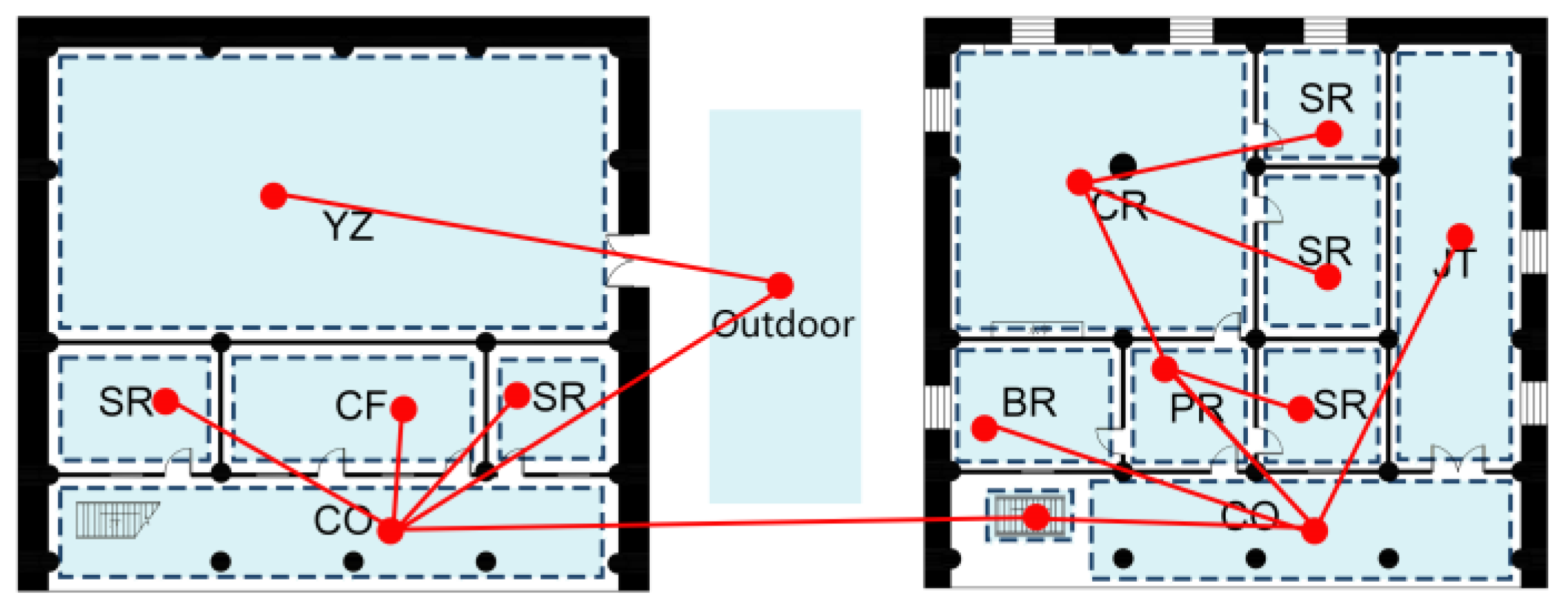


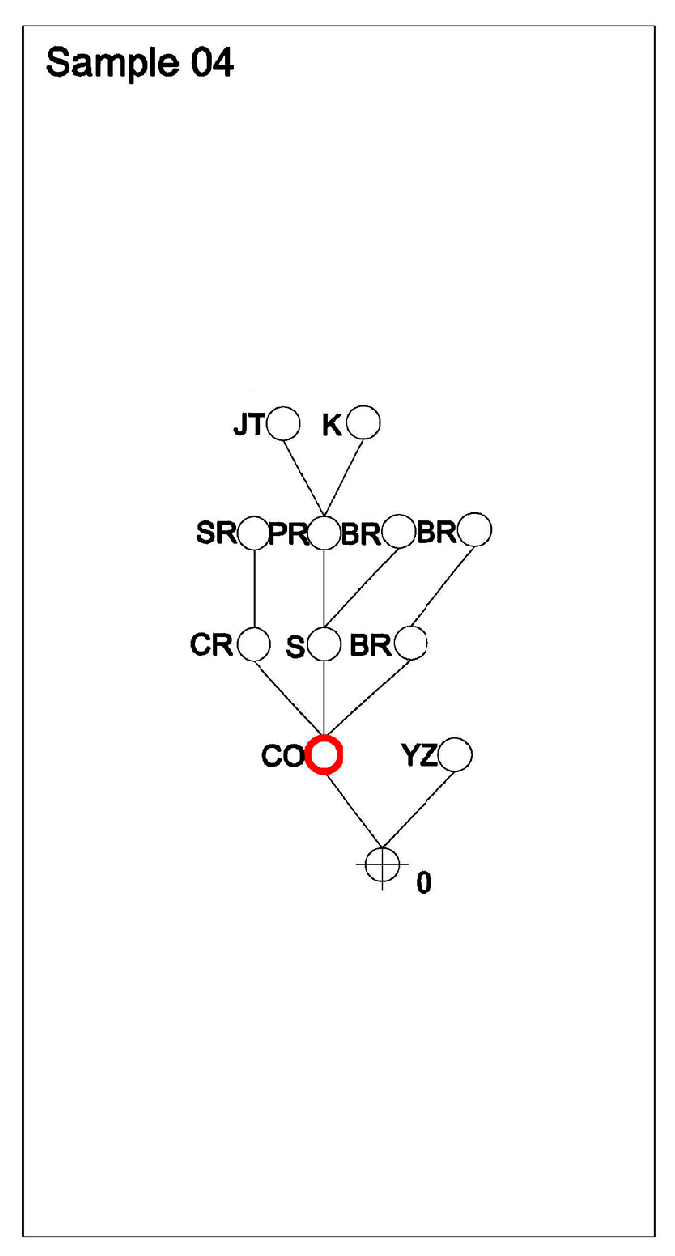
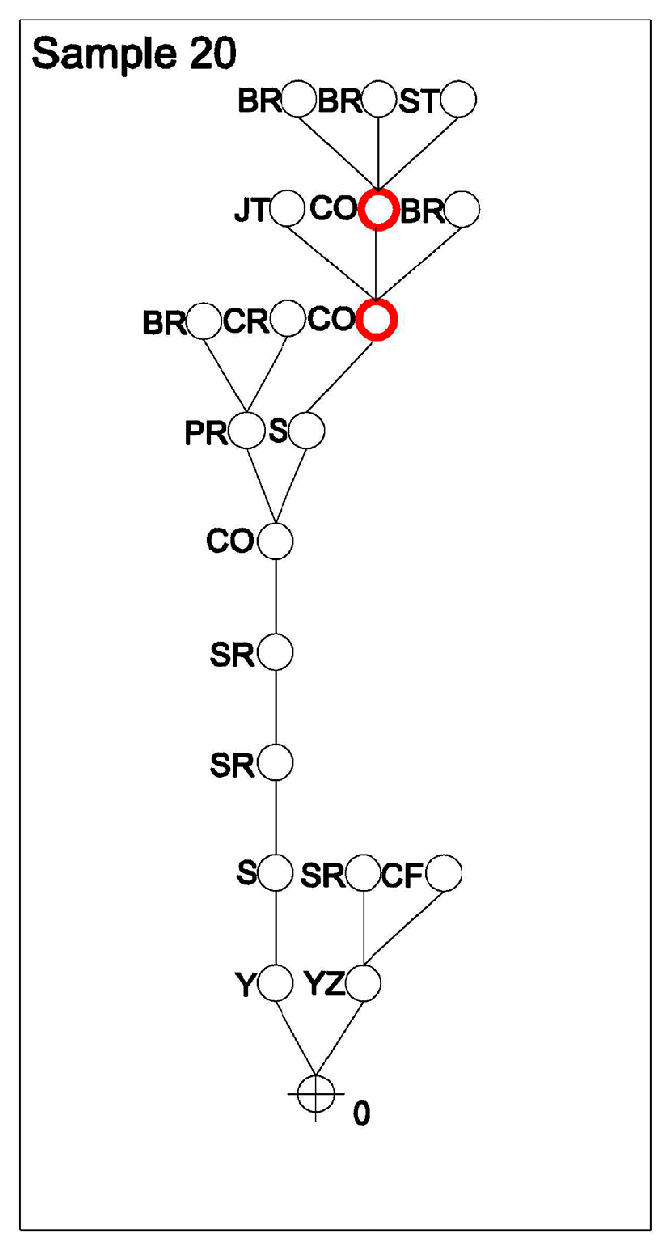




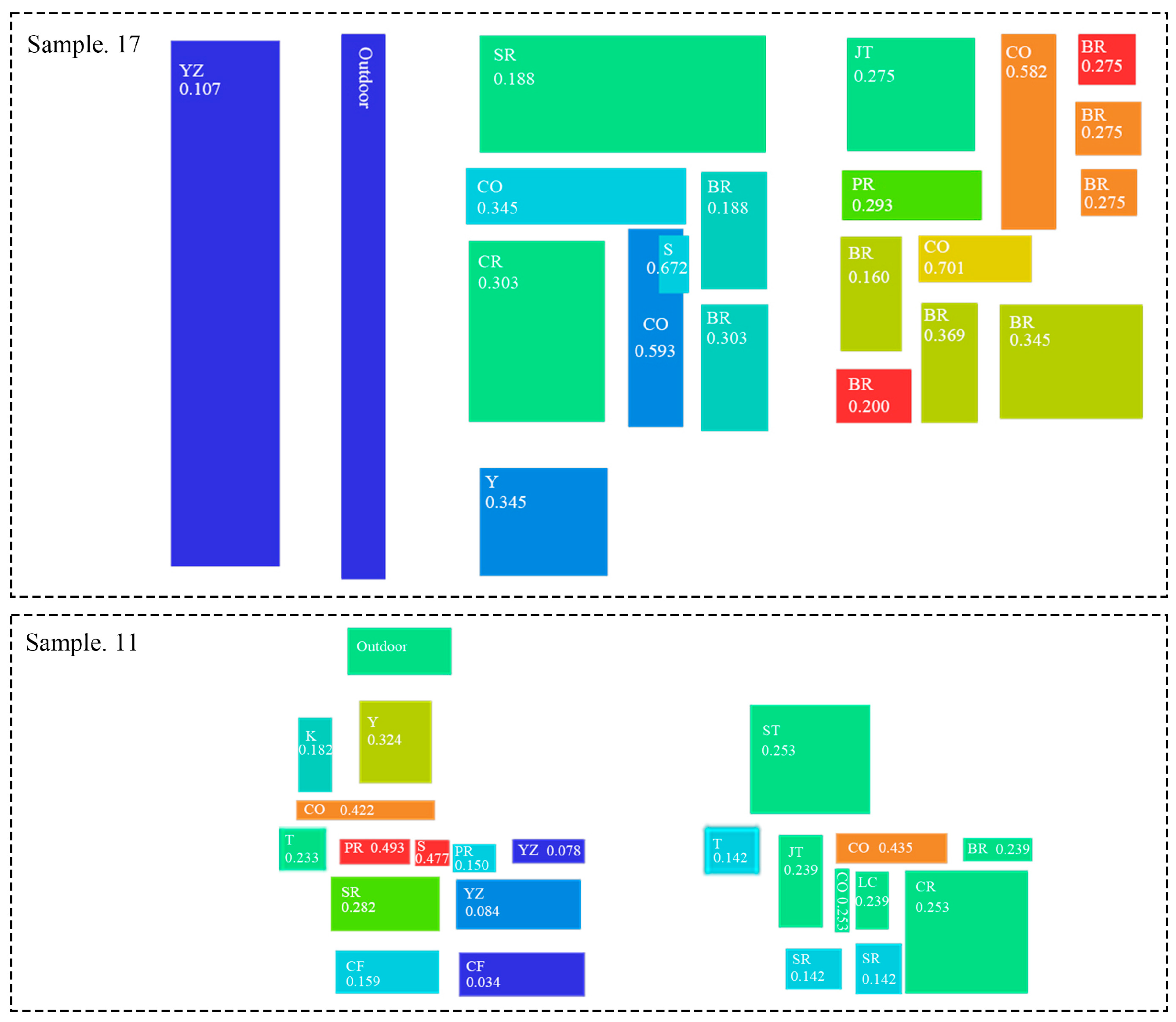

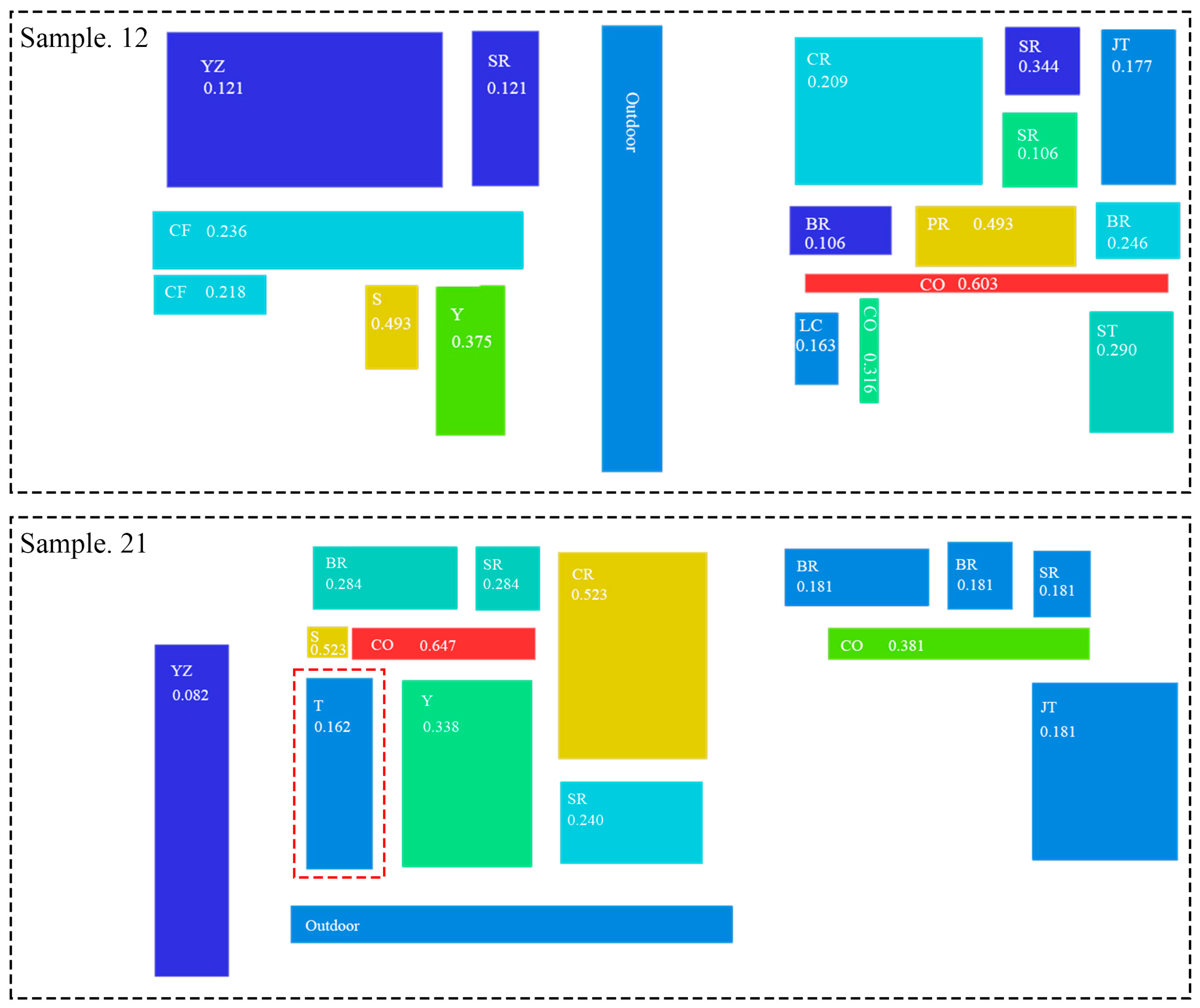
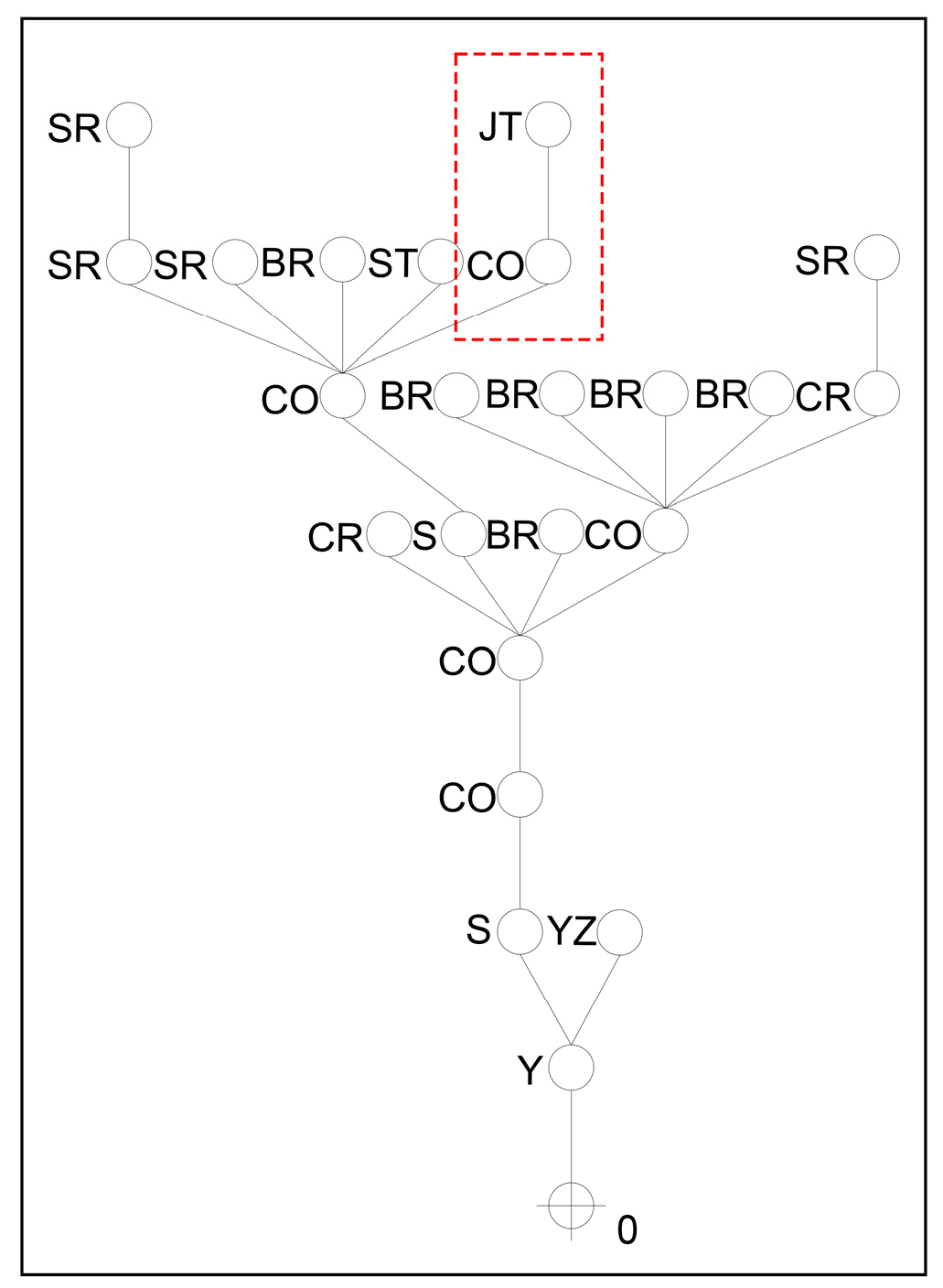
| Index | Formula and Parameter Description | The Spatial Meaning |
|---|---|---|
| Mean Depth (MD) | In the formula, TD(p) is the global depth value with the p space as the topological center, MD(p) is the average depth value with the p space as the topological center, and is the total number of topological structure nodes with the p space as the topological center. | In the theoretical system of space syntax, the depth value does not represent the actual distance. It represents the topological steps between each spatial node, which is manifested in the topological structure as the topological steps of one step between connected topological nodes. The mean depth value is based on the global depth value and excludes the influence of its vertices themselves. The larger the mean depth value of the spatial nodes is, the farther the space is from the central space. |
| Integration (IRRA) | In the formula are the relative asymmetric values with the p space as the topological center. | In the theoretical system of space syntax, real relative asymmetry was proposed to eliminate the influence of topological structure asymmetry on numerical calculation. The reciprocal of RRA is the degree of integration. The higher the degree of integration of a space, the stronger the accessibility of other spaces to this space, and the denser the social activities of humans in this space. |
| Normalized Choice (NACH) | It measures the number of times a certain spatial node appears on the connection path between any two spatial nodes. A higher value indicates that the spatial traffic is strong. |
| Sample Number | Spatial Type | M-IRRAvalue (Global) | M-NACHvalue (Global) | M-Mdvalue (Global) | M-IRRAvalue (Local) | M-NACHvalue (Local) | M-Mdvalue (Local) |
|---|---|---|---|---|---|---|---|
| 01 | Woodshed | 0.377 | 0.170 | 0.000 | 0.452 | 0.173 | 0.000 |
| 01 | Storage room | 0.366 | 0.179 | 0.159 | 0.327 | 0.230 | 0.273 |
| 01 | Storage room | 0.677 | 0.028 | 0.000 | 0.452 | 0.000 | 0.000 |
| 01 | Storage room | 0.527 | 0.083 | 0.000 | 0.452 | 0.065 | 0.000 |
| 01 | Scripture hall | 0.377 | 0.170 | 0.000 | 0.703 | 0.102 | 0.000 |
| 01 | Granary | 0.377 | 0.170 | 0.000 | 0.703 | 0.102 | 0.000 |
| 01 | Staircase | 0.147 | 0.479 | 0.612 | 0.515 | 0.357 | 0.269 |
| 01 | Staircase | 0.262 | 0.280 | 0.408 | 0.641 | 0.186 | 0.146 |
| 01 | ShaiTai | 0.308 | 0.229 | 0.000 | 0.829 | 0.136 | 0.000 |
| 01 | TangWu | 0.216 | 0.345 | 0.306 | 0.452 | 0.298 | 0.341 |
| 01 | Bedroom | 0.262 | 0.280 | 0.000 | 0.787 | 0.172 | 0.000 |
| 01 | Entrance hall | 0.101 | 0.612 | 0.872 | 0.389 | 0.442 | 0.434 |
| 01 | Entrance hall | 0.239 | 0.310 | 0.408 | 0.452 | 0.298 | 0.265 |
| 01 | Breeding area | 0.516 | 0.088 | 0.159 | 0.264 | 0.124 | 0.454 |
| 01 | Corridor | 0.170 | 0.428 | 0.499 | 0.658 | 0.263 | 0.124 |
| Value | Rank Mean | Median | Kendall’s W Coefficient | X2 | p | |
|---|---|---|---|---|---|---|
| MD | Global calculation | 1.133 | 0.377 | 0.538 | 8.067 | 0.005 *** |
| Local calculation | 1.867 | 0.62 | ||||
| IRRA | Global calculation | 1.867 | 0.268 | 0.538 | 8.067 | 0.005 *** |
| Local calculation | 1.133 | 0.204 | ||||
| NACH | Global calculation | 1.6 | 0.088 | 0.046 | 0.692 | 0.405 |
| Local calculation | 1.4 | 0.076 | ||||
Disclaimer/Publisher’s Note: The statements, opinions and data contained in all publications are solely those of the individual author(s) and contributor(s) and not of MDPI and/or the editor(s). MDPI and/or the editor(s) disclaim responsibility for any injury to people or property resulting from any ideas, methods, instructions or products referred to in the content. |
© 2025 by the authors. Licensee MDPI, Basel, Switzerland. This article is an open access article distributed under the terms and conditions of the Creative Commons Attribution (CC BY) license (https://creativecommons.org/licenses/by/4.0/).
Share and Cite
Wu, K.; Wang, H.; Liu, H.; Yin, M.; Xu, J.; Qiang, M.; Su, Y. A Study on the Inheritance and Differentiation of Spatial Forms of Vernacular Architecture in the Yunnan–Tibet Area. Buildings 2025, 15, 2087. https://doi.org/10.3390/buildings15122087
Wu K, Wang H, Liu H, Yin M, Xu J, Qiang M, Su Y. A Study on the Inheritance and Differentiation of Spatial Forms of Vernacular Architecture in the Yunnan–Tibet Area. Buildings. 2025; 15(12):2087. https://doi.org/10.3390/buildings15122087
Chicago/Turabian StyleWu, Kua, Haowei Wang, Heng Liu, Man Yin, Junhua Xu, Mingli Qiang, and Yanwei Su. 2025. "A Study on the Inheritance and Differentiation of Spatial Forms of Vernacular Architecture in the Yunnan–Tibet Area" Buildings 15, no. 12: 2087. https://doi.org/10.3390/buildings15122087
APA StyleWu, K., Wang, H., Liu, H., Yin, M., Xu, J., Qiang, M., & Su, Y. (2025). A Study on the Inheritance and Differentiation of Spatial Forms of Vernacular Architecture in the Yunnan–Tibet Area. Buildings, 15(12), 2087. https://doi.org/10.3390/buildings15122087




